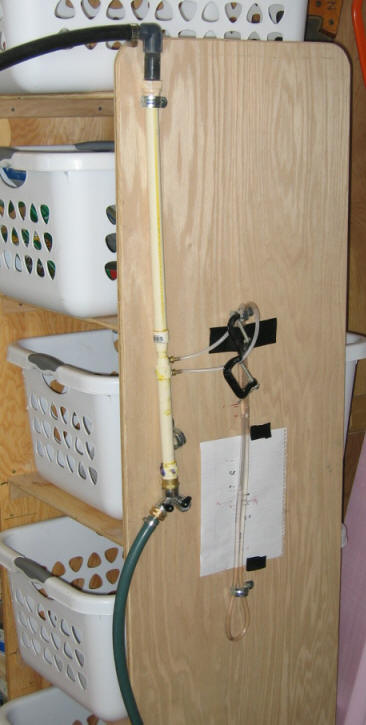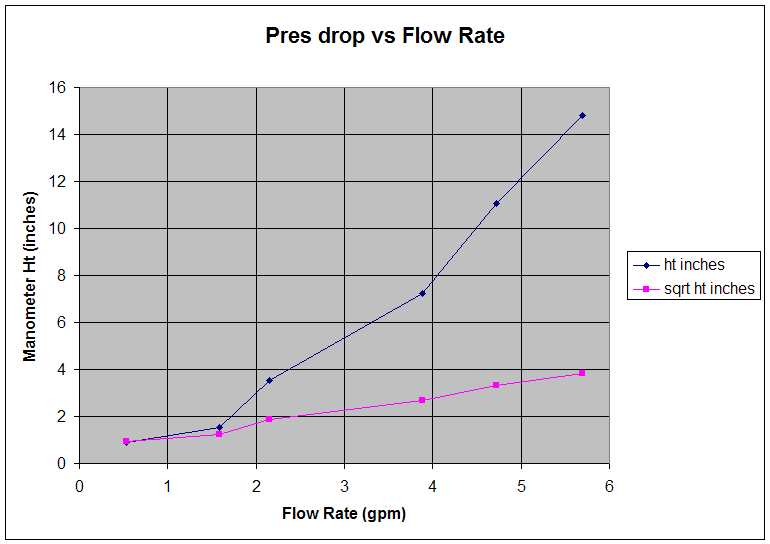
Search
The Renewable Energy site for Do-It-Yourselfers
$5 DIY Flow Meter
This is a first cut at a build it
yourself flow meter. It is made from two 3/4 by 1/2 CPVC pipe reducers
that are installed back-to-back with a short piece of 1/2 inch pipe connecting
them. Pressure taps are connected just upstream of the reducers and in the
reduced area section. The pressure difference between the two pressure tap
points is proportional to the square of the flow rate.
I measured the pressure difference
for several flow rates from about 0.5 gpm up to about 6 gpm (see plot below).
The flow rate does indeed seem to be linear with respect to the square root of
the pressure difference, just as the flow meter write-ups say it should be.
So, this seems to work. Flow rates were measured by timing the filling of
a bucket.
The down side:
The water manometer is kind of fussy
to work in this setup. Pressure pulses when the flow changes rapidly tend
to push the water out of the manometer. The clamps in the picture are an
attempt to damp this, and they help somewhat, but not perfect. A
small valve in each of the manometer input lines might do the trick?
The manometer water column tends to
break up sometimes -- adding a little detergent seems to help. Probably
using larger diameter tubing for the manometer section would also help? A
little ink in the manometer water makes it easier to read.
If you are measuring flow in a closed
system where the pressure can be fairly high, you would have to make the
manometer and the connections to resist the system pressure.
Another Pressure Sensor?
A different type of pressure sensor
or meter might work better than the water manometer.
Steve S. has suggested that this
Omega sensor might work:
http://www.omega.com/ppt/pptsc.asp?ref=PX26
Any other candidates??

Overview of flow meter and water
manometer.
Flow enters from garden hose
connection at the bottom, and flows up through the flow meter creating a
pressure difference between the higher velocity flow in the constriction and the
lower velocity flow below the constriction. The pressure difference is
proportional to the square of the flow rate. The water manometer to the
right measures the pressure difference.
The black outlet hose at the top goes to a calibrated bucket -- time to fill the
bucket is used to measure the actual flow rate.
The water manometer is just a U
shaped piece of tubing that is filled half way full with water. The two
top ends of the U are connected to the two pressure taps. When there is a
pressure difference between the two taps, the water falls on one side of the U
and rises on the other -- you just measure the difference in the water levels on
each side of the U -- this is the pressure difference in inches of water.

Close up of the two 3/4 by 1/2 CPVC
pipe reducers installed back to back. They are connected by a short piece
of 1/2 inch CPVC. The flow velocity increase in the 1/2 inch section
causes a pressure drop that is proportional to the square of the flow velocity.
The pressure taps just before the
restriction and in the restriction are just threaded to barbed connectors.
They are screwed into a slightly undersized hole in the CPVC with a little
silicone. The fittings should be screwed in until the end of the fitting
is just flush with the inside of the tube.
Plot of pressure difference between
the two taps for various flow rates.

One could just use this kind of graph
to make a scale with flow rates that could be taped in place behind the
manometer to read the flow rate directly off.


